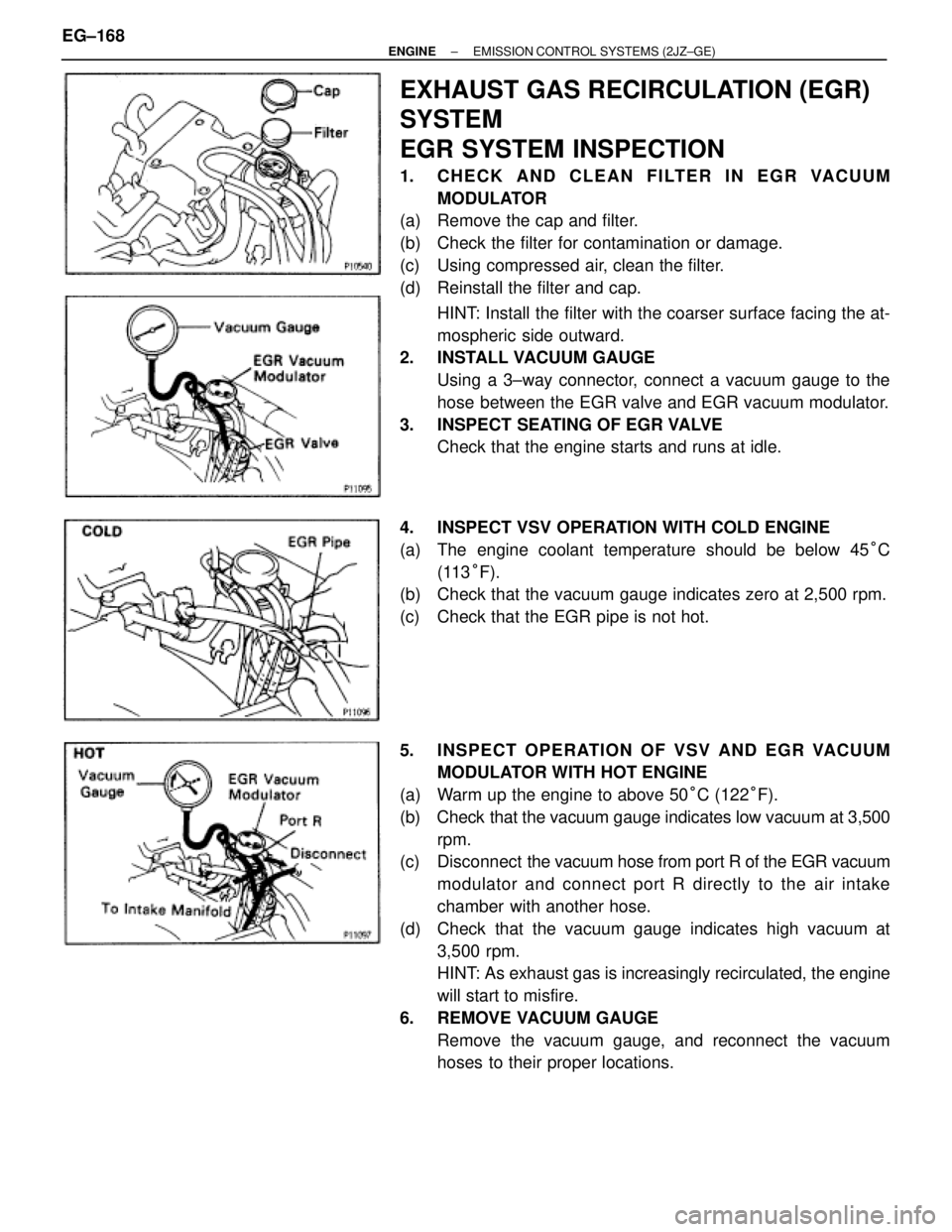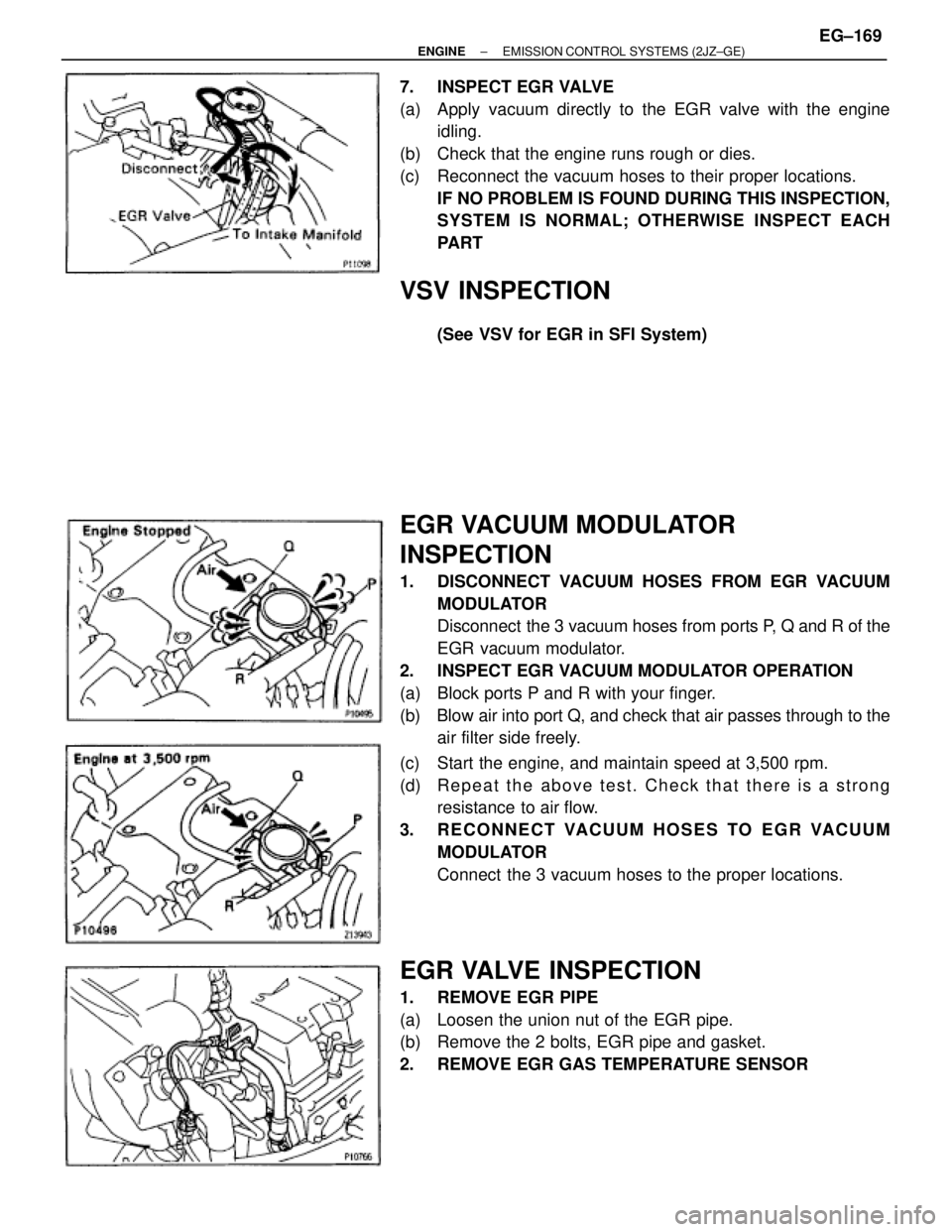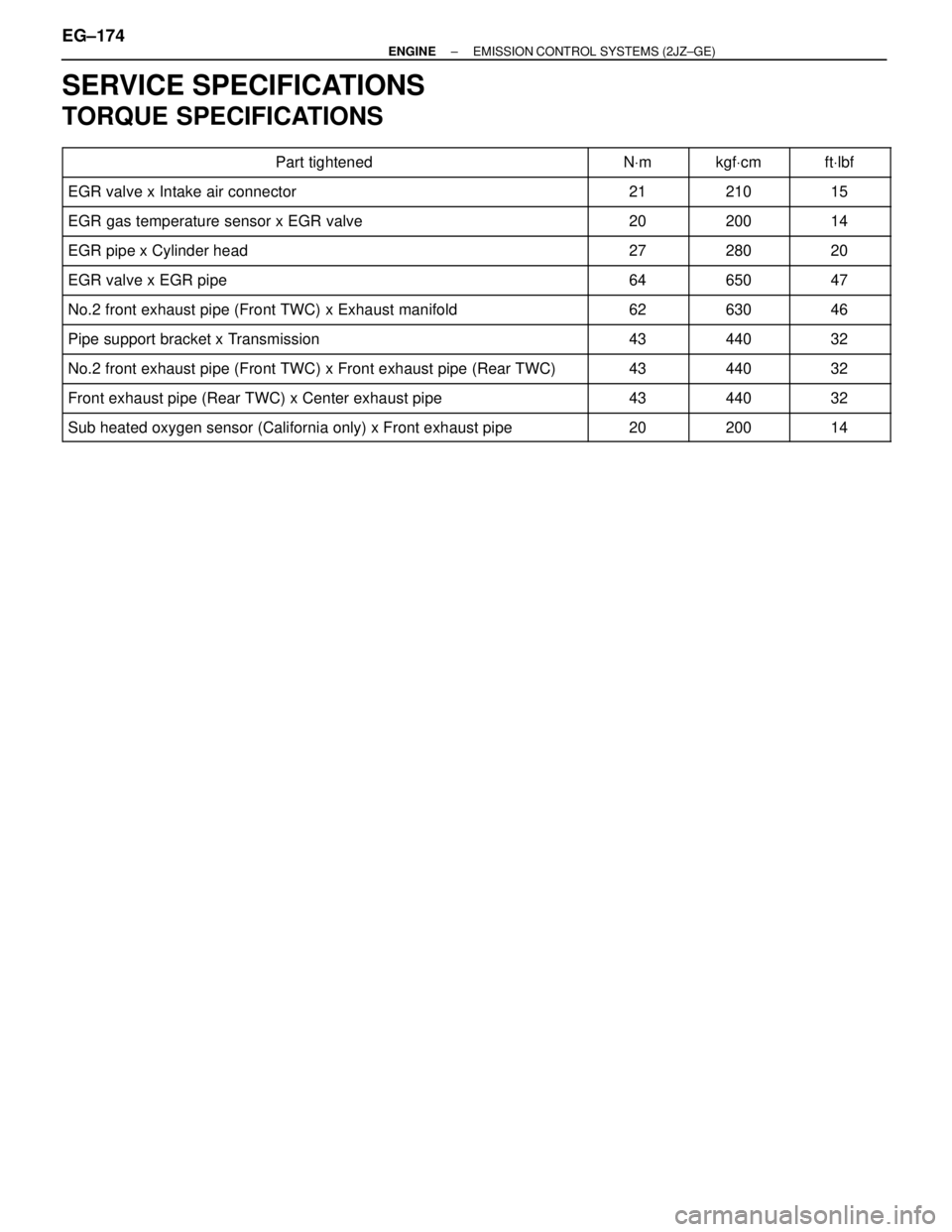Page 1115 of 2543
(b) Blow air (4.71 kPa (0.048 kgf/cm2, 0.68 psi)) into port A, and
check that air does not flow from the other ports.
If operation is not as specified, replace the charcoal canister.
4. CLEAN FILTER IN CANISTER
Clean the filter by blowing 294 kPa (3 kgf/cm
2, 43 psi) of com-
pressed air into port B while holding port A closed.
NOTICE:
�Do not attempt to wash the canister.
�No activated carbon should come out.
5. REINSTALL CHARCOAL CANISTER
VSV INSPECTION
(See VSV for EVAP in SFI System)
CHECK VALVE INSPECTION
1. REMOVE CHECK VALVE
2. INSPECT CHECK VALVE
(a) Check that air flows from the blue port to the black port.
(b) Check that air does not flow from the black port to the blue
port.
If operation is not as specified, replace the check valve.
3. REINSTALL CHECK VALVE
HINT: Install the check valve with the black port facing the
port P side of the throttle body.
± ENGINEEMISSION CONTROL SYSTEMS (2JZ±GE)EG±167
Page 1116 of 2543

EXHAUST GAS RECIRCULATION (EGR)
SYSTEM
EGR SYSTEM INSPECTION
1. CHECK AND CLEAN FILTER IN EGR VACUUM
MODULATOR
(a) Remove the cap and filter.
(b) Check the filter for contamination or damage.
(c) Using compressed air, clean the filter.
(d) Reinstall the filter and cap.
HINT: Install the filter with the coarser surface facing the at-
mospheric side outward.
2. INSTALL VACUUM GAUGE
Using a 3±way connector, connect a vacuum gauge to the
hose between the EGR valve and EGR vacuum modulator.
3. INSPECT SEATING OF EGR VALVE
Check that the engine starts and runs at idle.
4. INSPECT VSV OPERATION WITH COLD ENGINE
(a) The engine coolant temperature should be below 45°C
(113°F).
(b) Check that the vacuum gauge indicates zero at 2,500 rpm.
(c) Check that the EGR pipe is not hot.
5. INSPECT OPERATION OF VSV AND EGR VACUUM
MODULATOR WITH HOT ENGINE
(a) Warm up the engine to above 50°C (122°F).
(b) Check that the vacuum gauge indicates low vacuum at 3,500
rpm.
(c) Disconnect the vacuum hose from port R of the EGR vacuum
modulator and connect port R directly to the air intake
chamber with another hose.
(d) Check that the vacuum gauge indicates high vacuum at
3,500 rpm.
HINT: As exhaust gas is increasingly recirculated, the engine
will start to misfire.
6. REMOVE VACUUM GAUGE
Remove the vacuum gauge, and reconnect the vacuum
hoses to their proper locations. EG±168
± ENGINEEMISSION CONTROL SYSTEMS (2JZ±GE)
Page 1117 of 2543

7. INSPECT EGR VALVE
(a) Apply vacuum directly to the EGR valve with the engine
idling.
(b) Check that the engine runs rough or dies.
(c) Reconnect the vacuum hoses to their proper locations.
IF NO PROBLEM IS FOUND DURING THIS INSPECTION,
SYSTEM IS NORMAL; OTHERWISE INSPECT EACH
PART
VSV INSPECTION
(See VSV for EGR in SFI System)
EGR VACUUM MODULATOR
INSPECTION
1. DISCONNECT VACUUM HOSES FROM EGR VACUUM
MODULATOR
Disconnect the 3 vacuum hoses from ports P, Q and R of the
EGR vacuum modulator.
2. INSPECT EGR VACUUM MODULATOR OPERATION
(a) Block ports P and R with your finger.
(b) Blow air into port Q, and check that air passes through to the
air filter side freely.
(c) Start the engine, and maintain speed at 3,500 rpm.
(d) Repeat the above test. Check that there is a strong
resistance to air flow.
3. RECONNECT VACUUM HOSES TO EGR VACUUM
MODULATOR
Connect the 3 vacuum hoses to the proper locations.
EGR VALVE INSPECTION
1. REMOVE EGR PIPE
(a) Loosen the union nut of the EGR pipe.
(b) Remove the 2 bolts, EGR pipe and gasket.
2. REMOVE EGR GAS TEMPERATURE SENSOR
± ENGINEEMISSION CONTROL SYSTEMS (2JZ±GE)EG±169
Page 1118 of 2543
3. REMOVE EGR VALVE
(a) Disconnect these hoses from the EGR valve:
(1) Vacuum hose
(2) Pressure hose
(b) Remove the 2 nuts, EGR valve and gasket.
4. INSPECT EGR VALVE
Check for sticking and heavy carbon deposits.
If a problem is found, replace the EGR valve.
5. REINSTALL EGR VALVE
(a) Place a new gasket on the intake air connector.
(b) Install the EGR valve with the 2 nuts.
Torque: 27 NVm (280 kgfVcm, 20 ftVlbf)
(c) Reconnect the following hoses to the EGR valve:
wVacuum hose
wPressure hose
6. REINSTALL EGR GAS TEMPERATURE SENSOR
Torque: 20 NVm (200 kgfVcm, 14 ftVlbf)
7. REINSTALL EGR PIPE
(a) Temporarily install the union nut of the EGR pipe.
(b) Install a new gasket and the EGR pipe with the 2 bolts.
Torque: 21 NVm (210 kgfVcm, 15 ftVlbf)
(c) Tighten the union nut of the EGR pipe.
Torque: 64 NVm (650 kgfVcm, 47 ftVlbf)
EG±170± ENGINEEMISSION CONTROL SYSTEMS (2JZ±GE)
Page 1119 of 2543
THREE±WAY CATALYTIC CONVERTER
(TWC) SYSTEM
EXHAUST PIPE ASSEMBLY INSPECTION
1. CHECK CONNECTIONS FOR LOOSENSESS OR
DAMAGE
2. CHECK CLAMPS FOR WEAKNESS, CRACKS OR
DAMAGE
TWC INSPECTION
CHECK FOR DENTS OR DAMAGE
If any part of the protector is damaged or dented to the extent
that it contacts the TWC, repair or replace it.
HEAT INSULATOR INSPECTION
1. CHECK HEAT INSULATOR FOR DAMAGE
2. CHECK FOR ADEQUATE CLEARANCE BETWEEN
CATALYTIC CONVERTER AND HEAT INSULATOR
± ENGINEEMISSION CONTROL SYSTEMS (2JZ±GE)EG±171
Page 1120 of 2543
COMPONENTS FOR FRONT TWC
REMOVAL AND INSTALLATION
EG±172± ENGINEEMISSION CONTROL SYSTEMS (2JZ±GE)
Page 1121 of 2543
COMPONENTS FOR REAR TWC
REMOVAL AND INSTALLATION
± ENGINEEMISSION CONTROL SYSTEMS (2JZ±GE)EG±173
Page 1122 of 2543

SERVICE SPECIFICATIONS
TORQUE SPECIFICATIONS
����������������������� �����������������������Part tightened����� �����NVm������ ������kgfVcm����� �����ftVlbf
����������������������� �����������������������EGR valve x Intake air connector����� �����21������ ������210����� �����15
����������������������� �����������������������EGR gas temperature sensor x EGR valve����� �����20������ ������200����� �����14����������������������� �
���������������������� �����������������������EGR pipe x Cylinder head
����� �
���� �����27
������ �
����� ������280
����� �
���� �����20
����������������������� �����������������������EGR valve x EGR pipe����� �����64������ ������650����� �����47
����������������������� �����������������������No.2 front exhaust pipe (Front TWC) x Exhaust manifold����� �����62������ ������630����� �����46
����������������������� �����������������������Pipe support bracket x Transmission����� �����43������ ������440����� �����32����������������������� �
���������������������� �����������������������No.2 front exhaust pipe (Front TWC) x Front exhaust pipe (Rear TWC)����� �
���� �����43������ �
����� ������440����� �
���� �����32
����������������������� �����������������������Front exhaust pipe (Rear TWC) x Center exhaust pipe����� �����43������ ������440����� �����32
����������������������� �����������������������Sub heated oxygen sensor (California only) x Front exhaust pipe����� �����20������ ������200����� �����14
EG±174± ENGINEEMISSION CONTROL SYSTEMS (2JZ±GE)